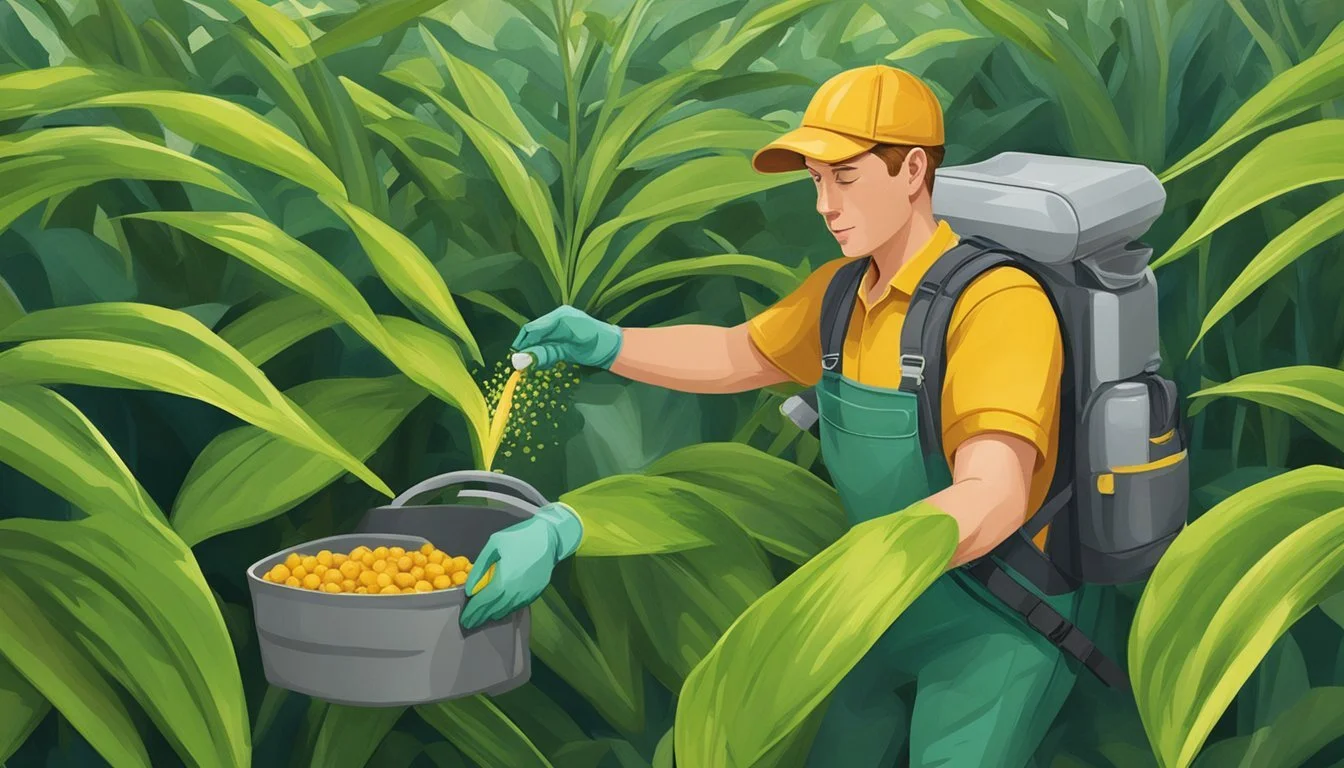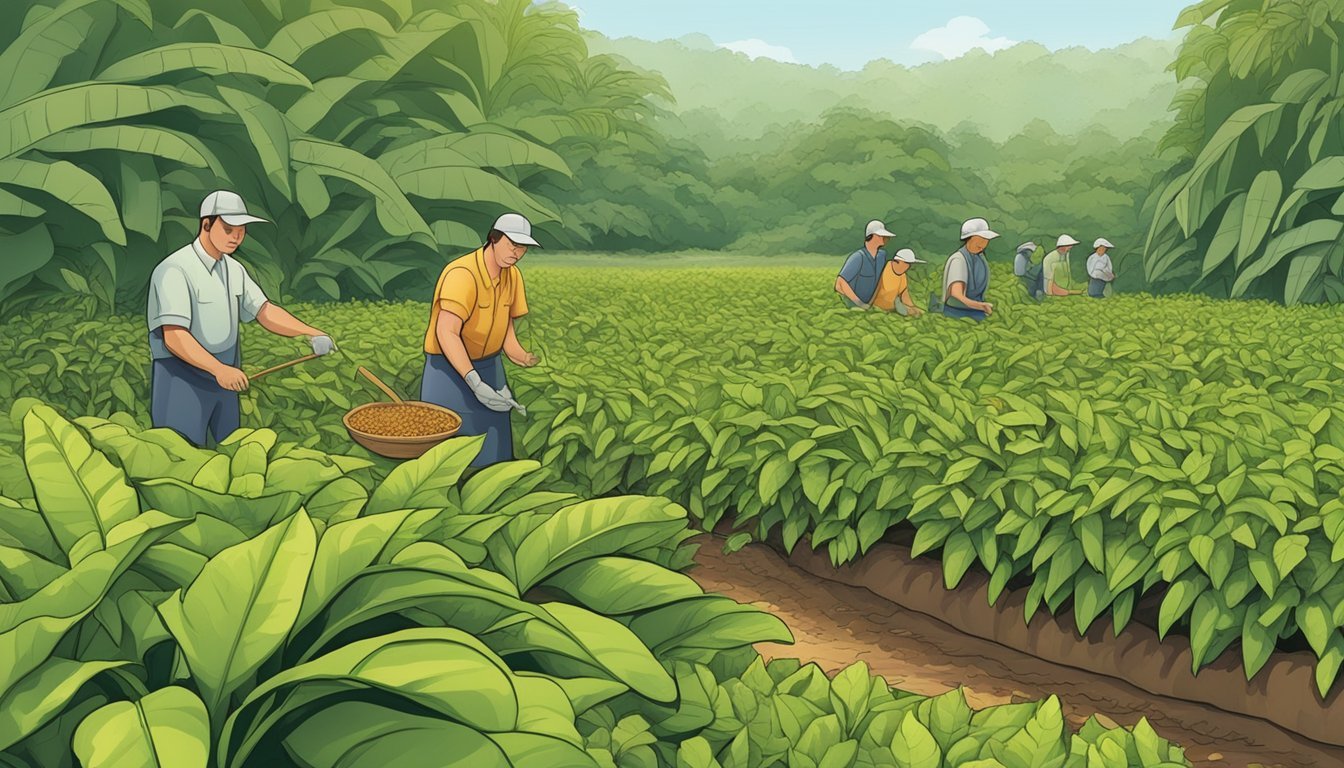Pest Control for Ginger
Effective Management Strategies
Ginger, a valued spice and medicinal plant, is cultivated for its aromatic rhizome and is an integral part of various culinary traditions worldwide. Like all crops, ginger plants can be susceptible to a variety of pests that can affect their growth and yield. Effective pest control in ginger cultivation is essential to ensure the health and productivity of the plants. Recognizing and managing pests promptly can prevent them from causing significant damage to the ginger crop.
Maintaining the health of ginger plants requires a strategic approach to pest management. Various insects, such as the ginger maggot and the aphids, can pose significant threats. The use of diatomaceous earth has been suggested to combat snails and slugs, which can devastate ginger plants by eating away at their foliage. Frequent monitoring is crucial; it enables early detection and intervention, thereby minimizing harm to plants and maximizing the effectiveness of pest control measures.
Effective pest control also involves understanding the life cycles of common ginger pests and the symptoms they exhibit on plants. For example, the presence of the ginger maggot, which is the pupae stage of a moth, can lead to spoilage especially during the storage phase. By integrating preventive measures and treatment options such as manual removal, use of natural predators, or controlled applications of insecticidal soaps, cultivators can protect their ginger plants from pest infestations and ensure a healthy harvest.
Understanding Ginger Plants
Ginger plants, known scientifically as Zingiber officinale, are tropical plants valued for their flavorful rhizomes. They thrive in specific environmental conditions and are cultivated worldwide.
Botanical Characteristics
Ginger is a perennial that primarily reproduces through vegetatively propagated sets. The part of the ginger plant commonly consumed is not a root, but a rhizome—a horizontal stem that often grows just below the surface of the soil and can also sprout shoots and roots. Ginger's leaves are green and glossy, while its flowers can vary in color from yellow to white, and occasionally a light pink.
Optimal Growing Conditions
Ginger plants perform best in warm climates with high humidity and filtered sunlight. They favor temperatures between 75°F and 85°F (24°C to 29°C), with a minimum temperature threshold of 50°F (10°C). Soil should be rich in organic matter, loamy, and have a pH between 5.5 and 6.5. It's crucial to water ginger sufficiently, especially during dry spells, with an annual rainfall or irrigation equivalent of at least 1500mm. However, waterlogged soils should be avoided, as they can cause root rot. Planting is typically done in the spring when the soil temperature is warm, and in some regions, pre-sprouted sets are used to ensure healthy growth. Adding lime or calcium may be necessary to achieve the optimal soil condition.
Common Pests in Ginger Cultivation
Ginger cultivation can be seriously affected by a variety of insect pests and diseases which compromise plant health and yields. Timely identification and effective treatment are crucial to control these problems.
Insect Pests
Insect pests are a major threat to ginger plants, often causing significant damage. Common pests include:
Aphids: These small, sap-sucking insects can cause distorted and stunted growth.
Spider Mites: These tiny pests infiltrate beneath leaves, spinning webs, and causing yellowing or bronzing of leaves.
Mealybugs: They feed on plant sap and excrete sticky honeydew, leading to sooty mold.
Cutworms: These caterpillars cut through stems at the soil line, often killing young plants.
Chinese Rose Beetles: They chew on leaves during the night, resulting in skeletonized foliage.
Thrips: They scrape at plant cells, leaving behind stippled or silvered leaf surfaces.
Root-Knot Nematode: These microscopic worms cause swollen roots, leading to stunted ginger growth.
Effective control measures include manual removal, use of insecticidal soaps, and introducing natural predators such as ladybugs. For more severe cases, recommended treatments may be used to curb these pests.
Diseases Affecting Ginger
Diseases can devastate ginger crops, often exacerbated by fungi, bacteria, and climate conditions:
Bacterial Wilt: Caused by the bacterium Ralstonia solanacearum, plants wilt and ultimately collapse.
Soft Rot: This fungal infection leads to water-soaked patches on leaves and rhizomes.
Dry Rot: Fungi cause the rhizome to dry and shrink, affecting the storage quality.
Rhizome Rot: Typically caused by Fusarium species, it results in reddish-brown rotting of the rhizomes.
Fungus-Nematode Complex Disease: A combination of fungal infection and nematode infestation leading to extensive crop damage.
Leaf Spot: Small spots on leaves that expand and can reduce photosynthesis.
Blight: Leads to leaf discoloration and can cause the death of plant tissue.
Preventative actions include proper field sanitation, crop rotation, and resistant varieties. Use of appropriate fungicides may be necessary for controlling these diseases. Regular monitoring and early intervention are key to managing these issues in ginger cultivation.
Pest Control Strategies
Effective pest control strategies encompass a blend of cultural, biological, and chemical methods to maintain the health of ginger plants. These strategies help manage the environment and ensure the application of control measures to mitigate pest-related issues.
Cultural Practices
Cultural practices involve altering the environment to make it less hospitable for pests. Regularly incorporating organic matter into soil improves the ginger plant health and helps suppress disease by enhancing the soil's natural fertility and structure. Initiating pest control in the nursery stage can prevent the spread of pests to the field. Additionally, mulching with diatomaceous earth around ginger plants deters soft-bodied insects such as slugs and snails by desiccating them upon contact.
Biological Treatments
Biological treatments leverage natural predators such as ladybugs to control pest populations. Introducing beneficial microbes like Trichoderma and Streptocyclin can suppress fungal pathogens. Application of neem oil and insecticidal soap provides a more environmentally friendly option compared to traditional insecticides, targeting pests while being safe for most beneficial insects.
Chemical Control Methods
When cultural and biological methods are insufficient, chemical control methods may be necessary. Utilization of insecticides should be precise and follow an integrated pest management plan. Regular sprays of bordeaux mixture or copper oxychloride fungicide treatments can effectively control fungal diseases. However, these treatments must be applied judiciously to minimize environmental impact and maintain a balanced ecosystem surrounding the ginger cultivation.
Harvesting and Post-Harvest Care
Harvesting ginger at the right time and providing proper post-harvest care are critical steps to ensure the longevity and quality of the produce. From determining the maturity of ginger plants to addressing common post-harvest diseases and optimizing storage conditions, this section delves into the specifics.
When and How to Harvest
Ginger harvest should occur when the leaves senesce—typically turning yellow—and stems fall over. This usually happens 7 to 9 months after planting. The most conclusive sign is when the plant's leaves start to dry out, indicating the rhizomes have matured. The harvesting process involves using a cutter bar to cut the plants above the ginger rhizomes, which are then lifted from the soil.
Post-Harvest Diseases
After harvest, ginger rhizomes are vulnerable to diseases like soft rot, dry rot, and mildew. Caused by pathogens such as Fusarium, Pseudomonas, and Pratylenchus complex, these diseases can severely affect ginger quality. To mitigate this, one can apply good agricultural and post-harvest practices to reduce infection rates, including removal of all infected plant material and ensuring optimal drying.
Storage and Handling
Proper storage and handling are paramount to maintain the integrity of the ginger post-harvest. Ginger should be cleaned of soil and dried in a cool, shaded area to prevent microbial growth. Organic matter should not come into contact with wet rhizomes to avoid the onset of rots. Ideal storage conditions include a low-humidity environment to let the rhizomes dry out gradually. These steps help in extending the shelf life of ginger, all the way from the final planting location to the consumer.
Ginger in Cuisine and Industry
Ginger, known scientifically as Zingiber officinale, is a versatile ingredient valorized for its potent flavor, often found in both fresh and powdered form. It is indispensable in cuisines worldwide and holds a significant place in the spice industry, especially in Southeast Asia where it originated.
Uses in Cooking
Ginger is an essential spice that imparts a warm, spicy flavor to a variety of dishes. Fresh ginger, identifiable by its tan skin and firm flesh, is a staple in many Asian cuisines, often used to flavor stir-fries, soups, and marinades. Its presence can transform a dish with its distinctive zing, providing an aromatic heat that is both bold and invigorating. Powdered ginger, on the other hand, is commonly used in baking and confectionery, adding a subtler, sweet-spicy note to cookies, cakes, and also spice mixes such as curry powders. Ginger also blooms, and these blooms are sometimes used as decorative garnishes, though they are not commonly consumed.
Fresh Ginger: Utilized for its spicy, aromatic flavor in savory dishes.
Powdered Ginger: Employed for its sweet-spicy warmth in baked goods.
Cultivar Selection for Different Purposes
Selecting the right ginger cultivar is crucial depending on its intended use in cooking and industry. While all ginger belongs to the species Zingiber officinale, there are several cultivars that vary in flavor intensity, heat, and fibrousness. For the spice industry, cultivars with high levels of essential oils and oleoresins are favored, as they yield a more potent flavor ideal for drying and grinding into spice powders. In contrast, certain Southeast Asian cuisines may prefer less fibrous and milder cultivars for use in fresh preparations. The choice of cultivar impacts the final taste and usability of the ginger in various applications, from the sharp bite in a stir-fry to the gentle warmth in a gingerbread.
High Oil Cultivars: Suitable for drying and spice production.
Milder Cultivars: Preferred for fresh culinary use.
Frequently Asked Questions
In this section, we delve into common concerns regarding pest control in ginger cultivation, providing specific methods, treatments, and preventative measures to aid in maintaining healthy ginger crops.
What are the most effective methods for managing pests in ginger cultivation?
Effective pest management in ginger involves regular monitoring, using diatomaceous earth for snails and slugs, introducing natural predators, and employing biological controls.
Which insecticides are recommended for treating pest infestations in ginger plants?
Recommended insecticides for ginger plants include insecticidal soaps and natural options like neem oil. These treatments are effective against various insect pests without causing significant harm to beneficial insects.
How can one identify and treat common diseases affecting ginger crops?
Common diseases in ginger can often be recognized by discolored or wilting leaves. Treating these diseases may require the use of fungicides and adopting integrated pest management practices to prevent disease spread.
What are the major insect pests known to affect ginger, and how can they be controlled?
Major pests include the Ginger Maggot, which can spoil ginger during storage, and aphids. Control measures include timely harvesting to avoid maggot infestation and spraying water or using insecticidal soap to manage aphid populations.
Which bugs are commonly attracted to ginger plants, and how can one deter them?
Snails, slugs, and aphids are attracted to ginger plants. Deterring them involves physical barriers like diatomaceous earth and encouraging beneficial insects that prey on these pests.
What are the recommended treatments for fungal infections in ginger crops?
Fungal infections can be managed by using approved fungicides, ensuring good crop sanitation, and using resistant ginger varieties. Regular inspection of crops is crucial to detect and address any fungal issues early on.





